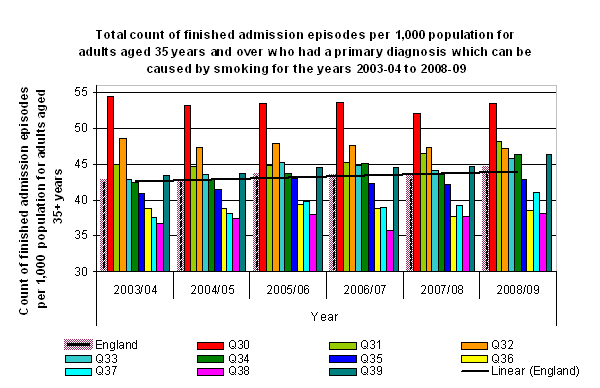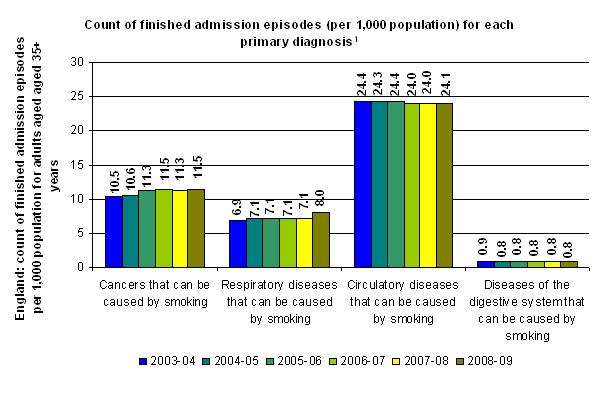IN THIS SITE...
Assessing trends in smoking-related ill health in England
There is a general agreement that smoking is one of the major contributory factors to some diseases such as some forms of cancer, respiratory diseases, and diseases of the circulatory and digestive systems. Consequently, the government has introduced a number of initiatives with the aim of reducing the number of patients who are admitted to hospitals or who may die as a result of smoking related ill-health. One of the recent initiatives was the smoking ban in public places. In this article we use data from Hospital Episodes Statistics (HES) to find out whether there have been noticeable changes and trends in the number of admission episodes where the primary diagnosis was smoking-related ill health.
Initiatives aimed at reducing smoking-related ill health
According to the Government White Paper 'Smoking Kills - A White paper on Tobacco, 1998', the main aim is to see a reduction in smoking, so as to improve health in Britain. This will be achieved by:
- reducing smoking among children and young people
- helping adults, especially the most disadvantaged, to give up smoking
- offering particular help to pregnant women who smoke.
In line with these objectives a number of initiatives have been undertaken. Some of them are listed below.
Smoking related initiatives:
- Smoking cessation, eg nicotine replacement therapy
- Smoking ban in all pubs and private members' clubs in England (from 1 July 2025).
Non-smoking related initiatives:
- Healthier diet (such as the 5 a day programme)
- Extending cancer screening
- Faster access to treatment.
The NHS Cancer Plan (July 2000) presents the government's strategy for investment and reform across the NHS, and gives cancer services high priority.
Patterns in HES
In the graph below we show the count of finished admission episodes in English NHS Hospitals and English NHS commissioned activity in the independent sector, for the years 2003-04 to 2008-09.
 |
Over the past 6 years, there have not been any dramatic changes or trends in the number of admission episodes where the primary diagnosis was smoking-related ill health, both across strategic health authorities and over the years. We note that North East SHA, North West SHA, and Yorkshire and The Humber SHA have admission figures per 1,000 population that are above the England average, while London SHA, South East Coast SHA and South Central SHA generally have admission figures below the average.
 |
Circulatory diseases that can be caused by smoking account for about 50 per cent of all admission figures with a smoking-related disease. Cancers that can be caused by smoking also account for a significant proportion (almost 25 per cent), with diseases of the digestive system that can be caused by smoking having the smallest number of admissions. (Data relating to the figure above can be downloaded from the Related documents area.)
It is noted that the count of finished admission episodes per 1,000 population for respiratory diseases that can be caused by smoking has increased considerably during 2008-09. However, it is not clear why there was this steep increase in the recorded cases compared to other years.
We further note that while the North West SHA has figures above the England average for respiratory, circulatory and diseases of the digestive system, the figures for cancers that can be caused by smoking are however below the England average over the six year period.
Thus even though there have been a number of initiatives that have been aimed at reducing the admission figures that have a smoking related element, recorded admission figures have not yet captured the anticipated benefits. This could be mainly because there is a time delay between the passing of the legislation or initiatives and the full realisation of most of the anticipated benefits of the initiatives. In any case the hospital episodes figures would only capture information about people that have been admitted to hospital.
Defining 'Diseases that can be caused by smoking'
Unfortunately, the definition of a smoking-related diagnosis is not clear cut. It has to be noted that even if an admission has a diagnosis that might be caused by smoking, not all the admissions would be attributable to smoking as there are other factors that might cause the diseases.
In this analysis we have used the International Classification of Diseases (ICD-10) codes given in the table below:
| ICD-10 codes and primary diagnosis description of cancers that can be caused by smoking | |
|---|---|
| Cancers that can be caused by smoking | |
| Upper respiratory sites | C00-C14, C32 |
| Oesophagus | C15 |
| Stomach | C16 |
| Pancreas | C25 |
| Lung | C33-34 |
| Cervical | C53 |
| Kidney | C64-66, C68 |
| Bladder | C67 |
| Unspecified site | C80 |
| Myeloid leukaemia | C92 |
| Respiratory diseases that can be caused by smoking | |
| Pneumonia | J10-J18 |
| Chronic obstructive lung cancer | J40-J44 |
| Circulatory diseases that can be caused by smoking | |
| Other heart disease | I00-I09, I26-I51 |
| Ischaemic heart disease | I20-I25 |
| Cerebrovascular disease | I60-I69 |
| Atherosclerosis | I70 |
| Aortic aneurysm | I71 |
| Other arterial disease | I72-I78 |
| Diseases of the digestive system that can be caused by smoking | J40-J44 |
| Stomach/duodenal ulcer | K25-K27 |
Assessing growth through time
HES figures are available from 1989-90 onwards. During the years that these records have been collected by the NHS there have been ongoing improvements in quality and coverage. These improvements in information submitted by the NHS have been particularly marked in the earlier years and need to be borne in mind when analysing time series.
Footnotes
1. Source
Hospital Episodes Statistics (HES) - Activities in English NHS Hospitals and English NHS commissioned activity in the independent sector.
2. Finished admission episodes
A finished admission episode is the first period of inpatient care under one consultant within one healthcare provider. Finished admission episodes are counted against the year in which the admission episode finishes. Please note that admissions do not represent the number of inpatients, as a person may have more than one admission within the year.


